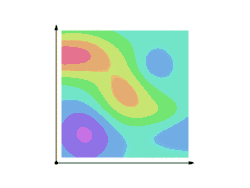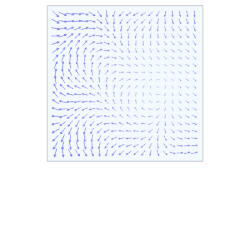Line integral
Introduction
The Curve, Line, Path or Contour integral expands the standard integral term for the Integration in the complex plane (Complex Analysis) or in the multidimensional space or . The path, the line or the curve, via which is integrated, is called the integration path[1]. The line integral over a closed path are written with the symbol .
Real-valued Line Integrale
A path is given which is imaged from an interval (e.g. interpreted as a time interval) into the vector space . indicates the place where the value is . The difference is
- Line integral first type and
- Line integral second type.
Pathintegral first type

The path integral of a continuous Function
along a continuously differentiable piece path is defined as
Deduction of the path
refers to the derivation from to . and are a vectors. The derivation vector indicates the change behavior in each component function of .
Remark - Component functions
The component functions are illustrations for which the derivation with the knowledge from the real analysis can be calculated.
Example of a path and its derivation
A differentiable path is defined first with
The track of the path forms an ellipse with the half axes 5 and 3.
Derivation of the path in the two-dimensional space
The derivation of the path results directly from the derivation of the component functions
Example - Deduction of the Way in the Three-dimensional Space
Now a vector is and . The derivation vector indicates the change behavior in each component function of .
Task
Draw the trail of the path in (Ellipse) and plotted the trail of the path in with CAS4Wiki plots.
Vector length of the derivation vector of the path
indicates the Euclidian norm of the vector .
Picture of the path - track
The image set of one piece differentiable curve in should not be confused with the graph of a curve which is a part of the .
Notes
- An example of such a function is a scalar field with cartesischen coordinaten.
- A path can pass through a curve either as a whole or only in sections several times.
- For , the path integral of the first type gives the length of the path .
- The path forms, inter alia on the starting point of the curve and on its end point.
- is an element of the definition set of and is generally not' for time. is the corresponding Differential.
Pathintegral second type

The line integral over a continuous gradient vector field
with a curve also parameterized in this way is defined as the integral over the scalar product of and :
Influence of parameterization
If and 'simplified' (d. h, and are identical This justifies the name curve integral; if the direction of integration is visible or irrelevant, the path in the notation can be suppressed.
Curve integrals
Since a curve is the image of a path , the definitions of the curve integrals essentially correspond to the path integrals.
Curve integral 1. type
Curve integral 2. type
Length of curve
A special case is again the length of the curve parameterized by :
Displacement element and length element
The expression occurring in the first type of curves
is called scalar path element' or 'length element.The expression occurring in the second type of curve integrals
is called 'vectorial path element'.
Rules of Procedure
Be , Curve integrals of the same type (i.e. either both first or second type), be the original image of the two functions and of the same dimension and be (698104789). The following rules apply to , and :
Notation for curve integrals of closed curves
If is a closed way, you write
- instead of also
and similar for closed curves
- instead of also .
With the circle in the Integral one would like to make clear that is closed. The only difference is in the notation.
Examples
- If is the graph of a function , this curve will be passed through the path
- parametrized with . About
- the length of the curve is equal
- A ellipse with large half-axis and small half-axis is parameterized by for . Your scope is therefore
- .
- In this case refers to the numerical eccenttricity of the ellipse. The integral on the right is referred to as elliptic tntegral due to this connection.
Path Independency on Integral
If a vector field is a Gradient field, i.e.
- ,
This applies to derivation of function composition of and
- ,
which exactly corresponds to the integral of the path integral over to .
Dependence of integral boundaries 1
This follows for a given curve
Visualization
The following image show two arbitrary curves and in a Gradient vector field connecting point with point .

Dependence of integral boundaries 2
This means that the integral of over depends solely on points and and the path between them is irrelevant to the result. For this reason, the integral of a gradient field is referred to as “displaced”.
Remark - closed paths - Ringintegral
In particular, the ring integral applies to the closed curve with two arbitrary paths and :
Application in Physics
This is particularly important in Physics, since, for example, the Gravitation has these properties. Since the energy in these force fields is always a conservation variable, they are referred to in physics as conservative force.
Scaler fields - Potential energy
The scalar field is the Potential or the potential Energy. Conservative force fields receive the mechanical energy, i.e. the sum of kinetic Energy and potential energy. According to the above integral, a work of 0 J is applied on a closed curve overall.
Number of revolutions
Path independence can also be shown with the application of the Integrability condition.

if the vector field is not possible as a gradient field only in a (small) environment of a point, the closed path integral of curves outside is proportional to the number of turns around this point and otherwise independent of the exact curve (see Algebraic Topology: Methodology).
Remark - Complex pathintegrale
If is replaced by , complex path integrals are treated which are treated in the Complex Analysis.
Literature
- Harro Heuser: Lehrbuch der Analysis – Teil 2. 1981, 5. Auflage, Teubner 1990, ISBN 3-519-42222-0. p. 369, Theorem 180.1; p. 391, Theorem 184.1; p. 393, Theorem 185.1.
References
- ↑ Klaus Knothe, Heribert Wessels: Finite Elemente. Eine Einführung für Ingenieure. 3. Auflage. 1999, ISBN 3-540-64491-1, S. 524.
See also
Page Information
You can display this page as Wiki2Reveal slides
Wiki2Reveal
The Wiki2Reveal slides were created for the Calculus' and the Link for the Wiki2Reveal Slides was created with the link generator.
- This page is designed as a PanDocElectron-SLIDE document type.
- Source: Wikiversity https://en.wikiversity.org/wiki/Line%20integral
- see Wiki2Reveal for the functionality of Wiki2Reveal.
Translation and Version Control
This page was translated based on the following Wikiversity source page and uses the concept of Translation and Version Control for a transparent language fork in a Wikiversity:
- Source: Wegintegral - URL: https://en.wikiversity.org/wiki/Wegintegral
- Date: 11/20/2024